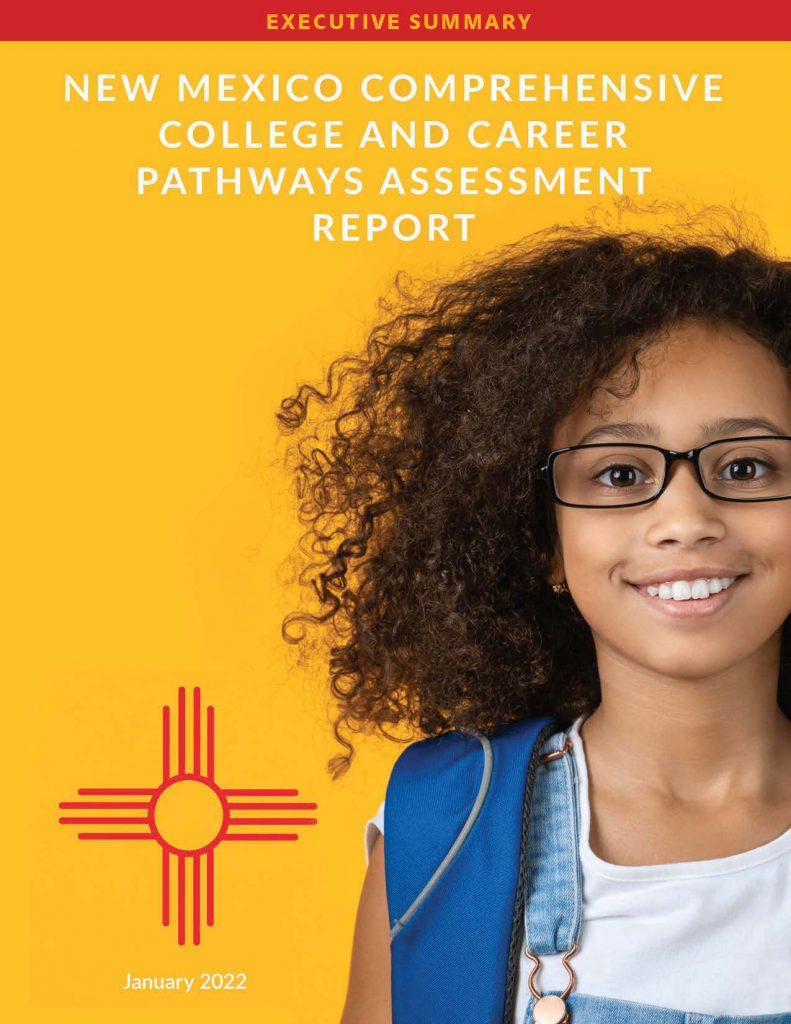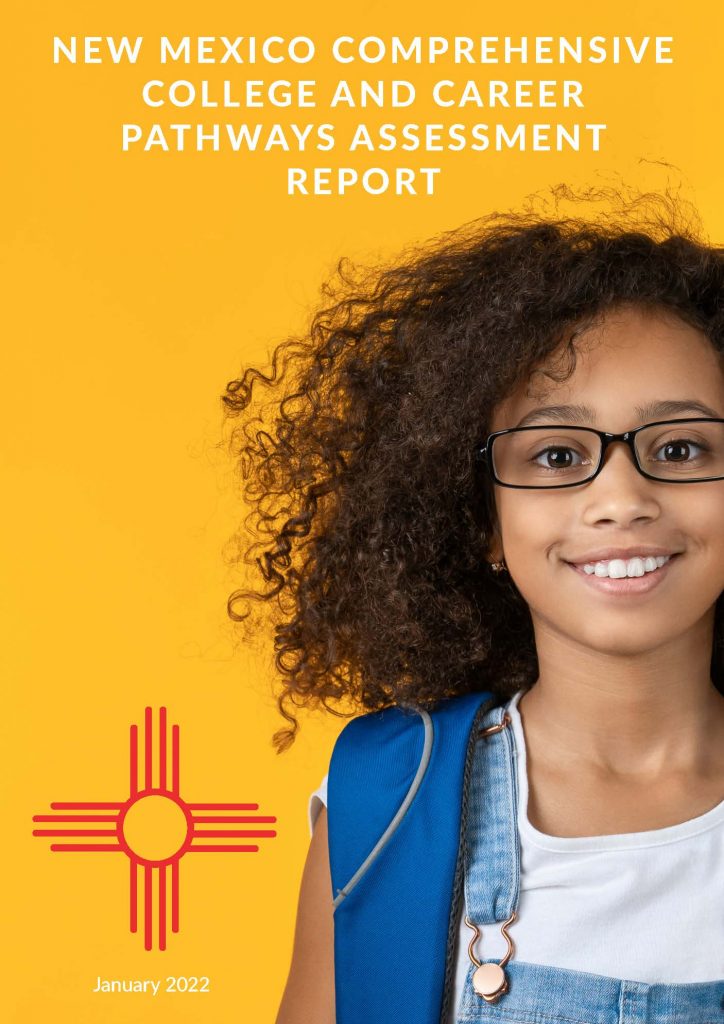
Introduction
Public schools use multiple strategies to prepare students for life after high school graduation, including rigorous academic course offerings aligned to higher education admission requirements; career and technical education (CTE) classes with work-based learning (WBL) opportunities; and a range of support services that target students’ need for social-emotional, academic, and career- related supports to become college or workforce-ready. These strategies prove to be most effective when implemented in coordination with one another and not as separate initiatives. In New Mexico, there have been multiple models, programs, and projects aimed at taking a comprehensive approach to improve the secondary experience and provide college and career preparation for students. While these attempts provide highly useful local examples of promising practices, they have fallen short of redesigning high schools in ways that engage all students. Neither have they been implemented at a scale that reaches a critical mass of New Mexico high schools.
The disappointing outcomes of New Mexico’s approaches are evidenced in the state’s data; high school graduation rates, the rates at which graduates are “college and career ready,” participation in career and college readiness opportunities, and the percentage of students enrolling in college after high school. In 2018, New Mexico ranked 33rd in the nation for the percentage of high school graduates enrolling in college. Approximately 61% of recent high school graduates (12,652 students) enrolled in postsecondary institutions within 12 months of graduation. In New Mexico, College and Career Readiness (CCR) participation is a school accountability measure used by the Public Education Department (PED), in combination with graduation rates. Participation in or obtaining credit in at least one of these activities is a graduation requirement; hence the overall CCR participation measure (78%) is consistent with the overall graduation rate (77%). In 2019-20, 65,102 New Mexico students (approximately 66% of the high school population) participated in CTE courses. However, only 16% (N = 15,433) of the high school population in New Mexico took more than two or more courses in a sequence, the minimum required to be a CTE concentrator. In SY 2019-20, approximately 15% of high school students were in dual credit, and a total of 2,485 high school students (approximately 3.8% of high school students in the state) participated in courses identified as WBL. Exploring these data points deeper revealed disparities within demographic subgroups, with too few students benefiting from college and career programming.
To address this statewide challenge, New Mexico needs a comprehensive strategy that weaves together promising local college and career-readiness practices with a robust statewide “college and career pathways” approach. To inform efforts, the New Mexico Public Education Department and the Los Alamos National Laboratory Foundation (LANLF) commissioned this research project to identify and assess the valuable lessons learned and progress made by schools, communities, the state, and tribes who have engaged in career and college readiness initiatives. These initiatives include High Schools that Work, the Next Gen CTE Pilot, the High School Redesign Network, Early College High Schools (ECHS), the Leadership Schools, the NACA Inspired Schools Network, and the College Horizons’ readiness programs. College and career readiness programs like these aim to support schools, districts, and communities to:
- align CTE with relevant core academics emphasizing real-world application, project-based learning, performance assessment, and personalized student supports;
- connect classroom instruction to a continuum of WBL experiences, including mentoring, job shadowing, internships, and school-based enterprise;
- provide a system of personalized student supports with attention to college and career advising and accelerated instruction in reading, writing, and mathematics; and
- provide all students, particularly at-risk students who are the focus of the Martinez/ Yazzie lawsuit, with sufficient, culturally- and linguistically-responsive programs and services necessary for them to be college and career-ready.
This project focused on two main questions for this report:
- What can be learned from PED initiatives and innovations already underway in New Mexico high schools and districts that can inform districts, schools, employers, and other community stakeholders seeking to implement the components listed above in an integrated way, based on a set of research-based standards that are appropriate for New Mexico?
- Using these learnings, what actions can the state government, tribal governments, and other entities take to promote and support such CTE and college and career pathways to transform high schools in ways that address the Martinez/Yazzie lawsuit findings?

Promising Practices from the Field
Local education, business, and nonprofit leaders from across New Mexico shared their perspectives and insights about promising practices and opportunities to enhance college and career pathways in New Mexico. Here are some examples:
ALIGNING CTE WITH CORE ACADEMICS
- Schools embrace a college- and career-bound culture and adapt structures and practices to expand course sequences that align CTE with core academics.
- Districts and schools are leveraging out-of-region institutions and building new partnerships, where necessary, to make aligned academics accessible for students.
- Schools worked to create a seamless transition between levels of schooling by developing strong ties with feeder schools, consistent and aligned communication and messaging about college and career opportunities, and providing students and families with in-depth information about the pathways at meetings and on the school or district websites.
CONNECTING INSTRUCTION WITH WORK-BASED AND EXPERIENTIAL LEARNING
- Schools with strong classroom connections to WBL and experiential learning opportunities demonstrated mutually beneficial relationships with local industry partners.
- Schools demonstrating a strong connection between instruction, WBL, and experiential learning consistently pointed to private grant funding as a critical source of additional support that robust connections require.
- Schools have helped bridge opportunity gaps by offering on-site learning experiences, creating numerous entry points to dual credit, WBL, CTE, internships, and capstone courses.
PROVIDING SYSTEMS OF PERSONALIZED SUPPORTS
- WBL and experiential learning opportunities that build positive relationships with adults and potential employers offer students from marginalized and underserved communities a way to expand their social capital, which is critical for long-term success.
- Schools providing school-based mentoring and individualized student advising provide students with smoother transitions between school levels and increased access to college and careers.
- Schools mitigate transportation barriers that create opportunity gaps through virtual spaces, on-site opportunities, and even co-locating with business partners.
- Dynamic professional development efforts such as teacher externships and paid training programs provide teachers with in-depth knowledge of the field to deliver instruction that most closely mirrors the workforce skills students will need for success in their chosen field.
ENSURING CULTURALLY AND LINGUISTICALLY RESPONSIVE PROGRAMS
- Successful practices centered students’ cultures and languages as a core function rather than a compliance activity due to the Martinez/Yazzie court ruling.
- Schools and districts identified and tackled systemic barriers by updating structures and policies that often prevent students from participating in essential academic opportunities in advanced courses.
- Programs committed to equity-focused expectations undergo regular evaluation processes that include constructive feedback and support to ensure the fidelity of comprehensive approaches, quality improvement, and equity in programmatic implementation.

Recommendations
Systemic change requires a complete paradigm shift in the way education agencies and schools approach college and career preparation and ultimately how students are supported throughout their time in the education system, from kindergarten through higher education. The following local- and tribal / state-level recommendations emerged from existing knowledge, research in best practices, data from secondary sources, qualitative and quantitative data from the advisory committee, and interviews with school sites as articulated in the Promising Practices section above. These recommendations hold students at the center and are grounded in four interrelated pillars; equity, integration, relationship, and responsibility.
EQUITY: The fundamental guiding principle for the research and the recommendations is to create systems that promote and support historically marginalized communities.
INTEGRATION: The recommendations must be integrated into the culture of each school and the community and should be inextricably aligned with the curriculum and student achievement goals.
RELATIONSHIP: The recommendations include student voice and building relationships between individuals and the community rather than a top-down structure, as this will support long-term change.
RESPONSIBILITY: Rather than focus on accountability with potentially negative connotations, responsibility focuses on each student’s assets and long-term care.
The team offers a suggested 4-year pilot project that connects these two levels of implementation and provides actionable steps that schools and districts can take up, reflected in the draft Request for Applications (RFA). Based on many of the conversations, the research team believes the local- level actions will be successful in the short term. Still, it is unlikely the change will be sustainable once the funds expire without tribal / state-level action. For a long-term systemic change, larger actions are necessary to create the conditions for promising practices in the field to thrive on an extensive scale.
Local Level Actions
I. COLLECTIVE PLANNING
- Establish a planning team to develop a college and career pathway map and plan that clearly illustrates pathways to college and career for students beginning no later than freshman year.
II. ALIGN CTE WITH CORE ACADEMICS
- Take steps to intentionally integrate CTE courses into the curriculum through team and project-based teaching approaches and redesign course schedules to offer aligned sequences and topical courses.
- Use available tools such as Graduate Profiles to develop community-based measures and data collection methods based on community stakeholder input and engagement.
III. CONNECT INSTRUCTION WITH WORK-BASED AND EXPERIENTIAL LEARNING
- Create on-campus, virtual, and summer internships that provide various modes of engagement and minimize transportation barriers for all students.
- Develop a campus lab initiative that integrates student learning opportunities into campus improvement and expansion projects.
IV. PROVIDE SYSTEMS OF PERSONALIZED SUPPORTS
- Establish school-based pathway teams to provide guidance and local expertise to PED, collect and submit data, and create strong support networks for students.
- Schools and districts should formalize higher education partnerships to establish strong career, internship, and employment programming that supports student work-based and experiential learning opportunities, including campus employment, paid internships for course credit, national service, and blended advisement.
V. ENSURE CULTURALLY AND LINGUISTICALLY RESPONSIVE PROGRAMS
- Align comprehensive pathway strategies to a Culturally and Linguistically Responsive (CLR) Framework that includes a system of personal supports, early and ongoing outreach and communication, and equity-focused participation, completion, and outcomes data.
- Conduct early, ongoing and adaptive outreach and communication regarding college and career options specifically addressing special populations’ needs, like English Language Learners (ELL), Students with Disabilities (SWD), and first-generation college-bound students.
Tribal / State Level Actions
I. DIRECT RESOURCES FOR COMPREHENSIVE STRATEGIES / INCREASE FUNDING
- Coordinate with the Department of Workforce Solutions (DWS) and philanthropy to build regional youth employment and opportunity funds to support Regional CTE programming, College and Career Pathway Coordinator roles, paid internships and apprenticeships, employer training, and experiential learning opportunities.
- Expand Local Education Agency (LEA) WBL and experiential learning budgets to support comprehensive college and career pathways planning, programs, and initiatives.
- Allocate and amplify dedicated funding for transportation in rural district budgets to support college and business field trips.
- The state should continue to improve broadband infrastructure (while acknowledging the need to be flexible with college and career pathways goals given the constraints) and work with schools and districts to adapt requirements and provide guidance on supporting students through the pathways when technical barriers emerge.
II. INCREASE DATA TRANSPARENCY AND EVALUATION SUPPORT
- Support equity-focused evaluation of all pathways programs to establish local best- practices guides and standards, including robust and formative assessments that help schools and districts problem-solve and remove the stigmas of punitive, deficit-focused evaluations.
- Create and maintain an online portal to encourage data collection and public dissemination of findings at state and local levels to understand the effectiveness of programs and whether they are meeting their equity goals.
III. STREAMLINE GOVERNMENT STRUCTURES
- Create a centralized State Coordination Office for College and Career Pathways to implement a cohesive and comprehensive college and career pathways system. This dedicated office with dedicated personnel can work at the intersection of PED, the Higher Education Department (HED), DWS, and Tribal governments. It can include a Director and Coordinator of a P-20 Alignment Team and facilitate a Youth Pathways Council for ongoing advisement and accountability to youth.
- Work with Tribal Leadership to develop Cultural Career Pathways. These Pathways will allow Native American students the opportunity to gain work skills related to important careers in tribal communities (e.g., language, arts, farming, etc.) and tribal leadership positions within their home communities.
IV. PROVIDE TARGETED SUPPORT AND GUIDANCE
- Provide administrative training in budgeting, redesigning schedules, and equity-focused data for sustained change.
- Develop an equity training program and expand professional development to support culturally responsive college and career programming practices. The program should include college and career readiness training (teaching students self-advocacy, note-taking, test-taking, soft-skills development, and other college and career readiness skills) for all teachers at every level of education.
- Incentivize training and recruitment of bilingual and special education teachers to meet the linguistic and ability needs of the diverse student population in New Mexico.
- Host a state/local business and education summit to develop relationships between sectors, break down the silos and barriers, allow for broad partnerships, and encourage deeper collaborations for student postsecondary and career success.
4-Year Pilot Program
The research team recommends that the PED implement a 4-year pilot program, informed by promising practices from New Mexico, to facilitate the expansion of comprehensive college and career pathways. This pilot program would create the opportunity for districts, schools, and communities to work closely with the PED and tribes to design, implement and assess compre- hensive approaches. The pilot also allows PED to use the learning from ongoing implementation to design a long-term, statewide plan that scales comprehensive college and career pathways.

Conclusion
In essence, we cannot shuffle the cards and hope for a better deal; we must call for a new game, one that builds on our communities’ wealth and does not seek to further marginalize their potential. As one advisory team member stated, “We know what needs to be done.” The question is: do we have the energy and vision to actualize what our students are surely capable of achieving? These findings and recommendations present community success and community knowledge that can provide a pathway for those who have the passion and determination to build a stronger system for all students throughout New Mexico.
Written by Erica Surova, M.A., MAG., Lee Francis IV, PhD, and Meriah Heredia-Griego, PhD for the Los Alamos National Laboratory Foundation and the NM Public Education Department.


